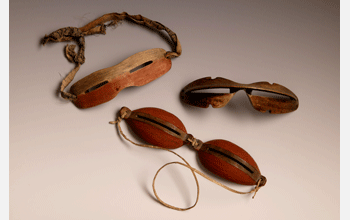Multimedia Gallery
Yup'ik Eskimo Exhibition
Yup'ik Eskimo Exhibition
Snow goggles (igauget), once used by Yup'ik Eskimo hunters to reduce glare and increase distance vision, are part of the "Yuungnaqpiallerput (The Way We Genuinely Live): Masterworks of Yup'ik Science and Survival" exhibition at the Anchorage Museum. By reducing unwanted light and limiting the vertical field of view, the goggles would allow an observer to see further into the distance and scan the horizon without moving their head, useful advantages for a hunter on the bright snow-covered landscape.
The exhibition, a joint project of the Anchorage Museum and the Calista Elders Council, was developed with the guidance of Yup'ik elders and educators. The exhibition explores the relationship between art, science and ethnography within the Yup'ik way of life, and presents more than 200 remarkable 19th and early 20th century tools, containers, weapons, watercraft and clothing in an exploration of the scientific principles and processes that allowed these people to survive in the sub-arctic tundra of the Bering Sea coast. There is also an online exhibit, which can be viewed Here.
Exhibition sponsors include the National Science Foundation, Totem Ocean Trailer Express, Northern Air Cargo, Alaska Airlines, BP, ConocoPhillips Alaska, Calista Corporation and the Anchorage Museum Association. This exhibit will run at the Anchorage Museum Feb. 3, 2008, through Oct. 26, 2008, and will travel to museums in Fairbanks and Juneau, Alaska, and Washington, D.C., from 2009-2010.
Research for the exhibition was supported by NSF's Office of Polar Programs (grants OPP 96-15086 and OPP 99-09945); exhibition planning and implementation were supported by NSF's Division of Informal Science Education (grants ESI 05-15387 and ESI 03-24685). (Date of Image: 2007)
Credit: Photographer Chris Arend; Anchorage Museum
Images and other media in the National Science Foundation Multimedia Gallery are available for use in print and electronic material by NSF employees, members of the media, university staff, teachers and the general public. All media in the gallery are intended for personal, educational and nonprofit/non-commercial use only.
Images credited to the National Science Foundation, a federal agency, are in the public domain. The images were created by employees of the United States Government as part of their official duties or prepared by contractors as "works for hire" for NSF. You may freely use NSF-credited images and, at your discretion, credit NSF with a "Courtesy: National Science Foundation" notation.
Additional information about general usage can be found in Conditions.
Also Available:
Download the high-resolution JPG version of the image. (2.3 MB)
Use your mouse to right-click (Mac users may need to Ctrl-click) the link above and choose the option that will save the file or target to your computer.

